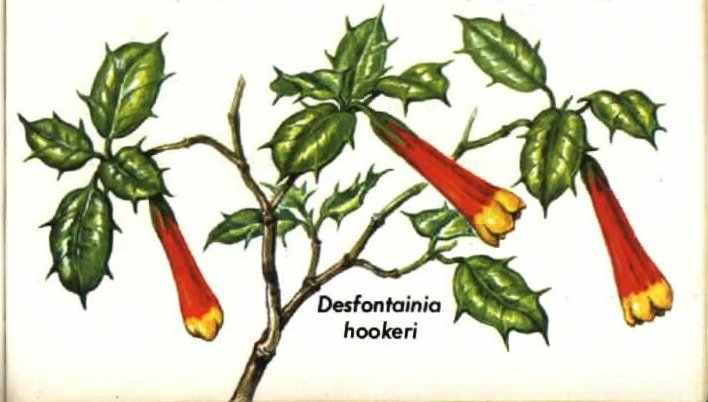Golden Guide: Hallucinogenic Plants
pages 141 to 150
.
Contents...1-10...11-20...21-30...31-40...41-50...51-60...61-70...71-80...81-90
91-100...101-110...111-120...121-130...131-140...141-150...151-156...Index
(Brunfelsia continued)
The species hallucinogenically employed are B. grandiflora and B. chiricaspi. All species, however, enter into folk medicine, being used especially to reduce fevers and as antirheumatic agents. B. uniflora (as B. hopeana) has been included in the Brazilian pharmacopoeia.
Chemical investigation of the active compounds in the various species of Brunfelsia is still in the initial stage, and what the active principles may be has not yet been determined. The genus comprises 40 species of shrubs native to tropical South America and the West Indies. It belongs to the nightshade family, Solonaceae.
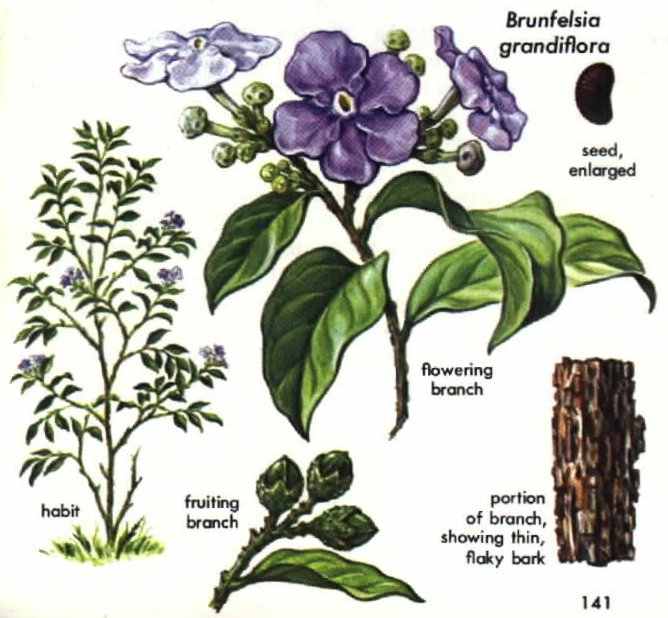
DATURAS (Datura) form a genus of some 20 species of the nightshade family, Solanaceae. They occur and are used as hallucinogens in both hemispheres. The drug is usually prepared by dropping pulverized seeds into fermented drinks or by steeping leaves and twigs in water. Use differs widely from tribe to tribe.
Intoxication caused by the drug is characterized initially by effects so violent that physical restraint must be imposed until the partaker passes into a stage of sleep and hallucinations. The medicine man interprets the visions as visitations of the spirits and is supposedly thus able to diagnose disease, apprehend thieves, and prophesy the future.
Some of the Indians in the Andes of southern Colombia cultivate a number of clones of highly atrophied "varieties," perhaps incipient species. They may be the result of mutations induced by viruses. Biological monstrosities, their identification to species is often difficult.. Medicine men maintain that they differ in potency from the usual Daturas, an indication that perhaps their chemical constitution as well as their morphology has been changed. They seem to be confined to Sibundoy, a mountain-girt valley in the high Andes of Colombia.
Basically, all species of Datura have a similar chemical composition. Their active principles are mainly hyossyamine and scopolamine, which are tropane alkaloids. Scopolamine is often the major constituent. A number of minor, chemically related alkaloids may be present: atropine, norscopolamine, meteloidine. The differences among species are chiefly in the relative concentrations of these various alkaloids. Though highly toxic, most species have been used extensively in medicine from early times to the present. Their use in folk medicine derives from their high concentration of alkaloids.
JIMSON WEED or thorn apple (Datura stramonium) is an illscented weedy annual with white to purplish flowers. Probably native to North America, it now grows in temperate and subtropical regions around the world. All parts of the plant, especially the brownish-black seeds, are toxic. This species is believed to have been the chief ingredient of wysoccon, used by the Algonquin Indians of eastern North America before the ritual of initiation into manhood ( see p. 9).
TORNA-LOCO (Datura ceratocaula) is a fleshy plant with thick, forking stems that grows in marshes and shallow waters. Its unusual habitat and its strong narcotic properties earned it a special place among the ancient Mexican hallucinogens. The Aztecs, who invoked its spirit in treating certain diseases, referred to it as "sister of ololiuqui," one of the morning glories (see p. 128). Its modern Mexican name, tornaloco ("maddening plant"), indicates its potency as a narcotic.
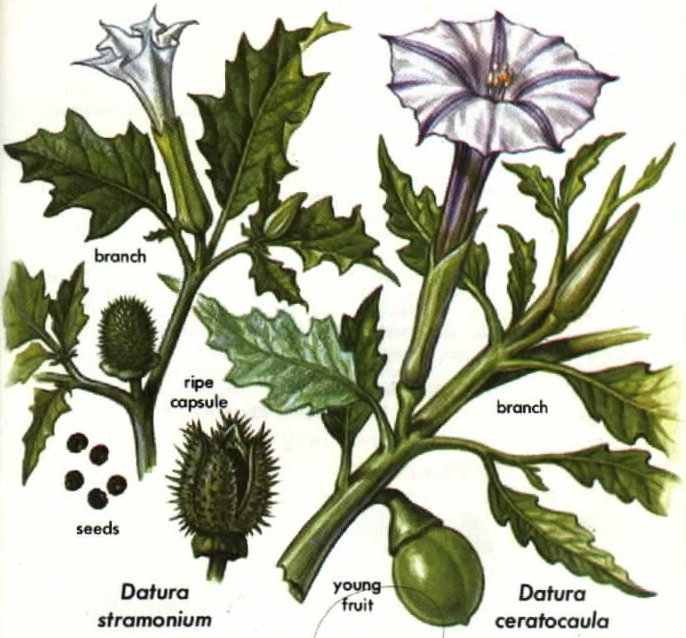
TOLOACHE (Datura inoxia; known also as D. meteloides), a coarser climbing annual native to Mexico and southwestern United States, has a long history of use as an hallucinogen. It was extremely important to the Aztecs, who called it toloatzin. Hernández recorded many medical uses but warned that taken in excess it would drive a patient to madness.
The modern Tarahumares still add the roots, seeds, and leaves to their maize beer. Zunis value the plant as a narcotic, an anesthetic, and a poultice for treating wounds. Only the rain priests are permitted to gather it. The priests put the powdered root in their eyes; also they chew the root to commune with spirits of the dead, asking intercession for rain.
The Luiseños use an infusion of toloache in an initiation ceremony. The young participants who drink it dance, screaming like animals, until they drop and succumb to the drug's effects. Yumans take it to induce dreams, gain occult powers, and predict the future. Yokuts use the drug in a spring ceremony to assure good health and long life to the young. The related D. discolor and D. wrightii of the same region are similarly used.
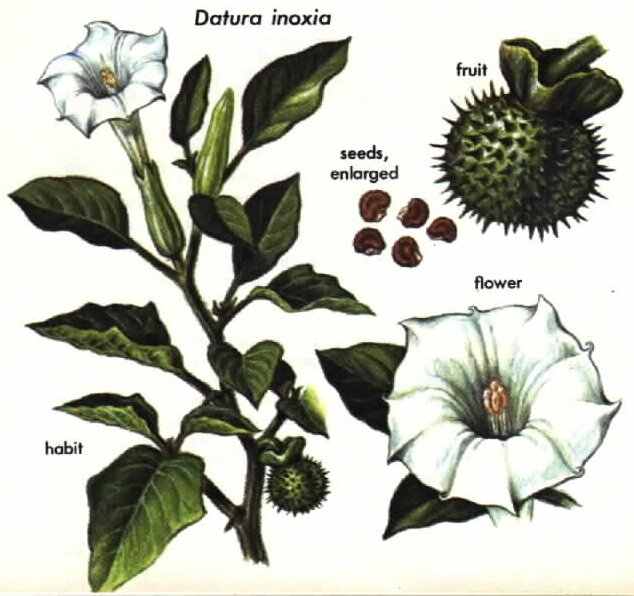
TREE DATURAS of several species are native to South America where they go by such native names as borrachero, campanilla, maicoa, floripondia, huanto, toé, and tanga. All are cultivated plants, unknown in the truly wild state and associated with man since earliest times.
Datura suaveolens is indigenous to the warmer lowlands. Recognized as toxic and narcotic, it is used as an hallucinogen, alone or as an admixture. The northern Andes, from Colombia to Peru, appears to be the center of the group's origin. Species from this region are D. arborea, D. aurea, D. candida, D. dolichocarpa, D. sanguinea, and the newly discovered D. vulcanicola (see pp. 146-147 for examples).
Aboriginal peoples from Colombia to Chile value these trees as sources of ritualistic hallucinogens and medicines. In Chile, the Mapuche Indians use D. candida and D. sanguinea to correct unruly children. The Jivaros say that the spirits of their ancestors admonish recalcitrant children during the hallucinations. The ancient Chibchas of Bogota used D. aurea seeds to induce stupor in the wives and slaves of dead warriors and chieftains before they were buried alive to accompany husbands and masters on the last trip.
At Sogomoza, Colombia, Indians took D. sanguinea ceremonially in the Temple of the Sun. The narcotic prepared from this red-flowered species is known locally as tonga. Many Peruvian natives still believe that tonga permits them to communicate with ancestors or other departed souls. In Matucanas, Peru, Indians say it will reveal to them treasures preserved in ancient graves, or huacas, hence the local name for the plant--huacacachu ("grave plant"). The tree daturas are sometimes considered a distinct genus: Brugmansia.
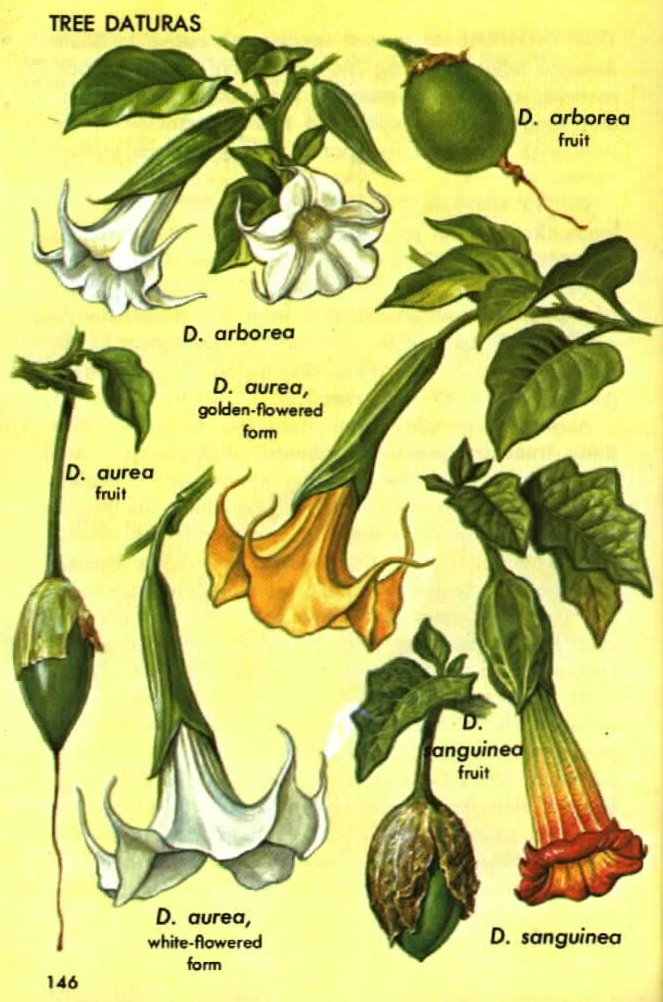
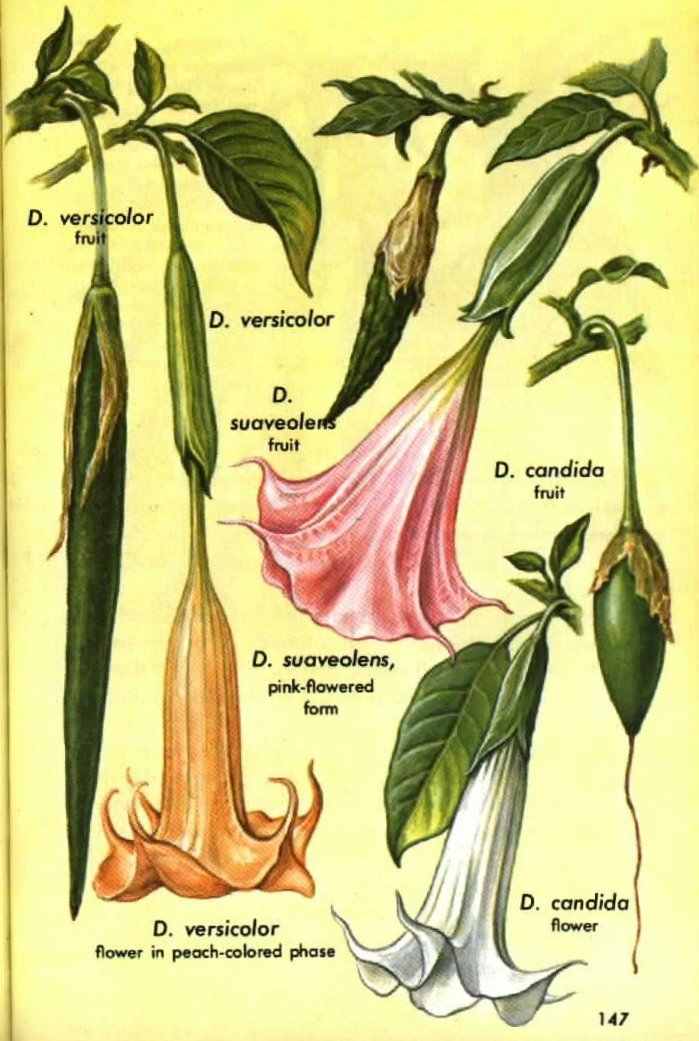
Sibundoy Indion witch doctor collecting leaves and flowers of Methysticodendron amesianum. Perhaps nowhere in the New World does the importance of hallucinogens in native magic and medicine acquire such significance as in the Valley of Sibundoy, which has been characterized as "the most narcotic conscious area of the New World."
CULEBRA BORRACHERO (Methysticodendron amesianum), a tree reaching a height of 25 feet, is known only from cultivated trees in the Kamsá Indian town of Sibundoy, Colombia. The Indians also call it mitskway borrachera ("snake intoxicant").
This tree is the only species of its genus and may represent an extremely aberrant form of a tree species of Datura. Its 11 - inch white flowers differ from those of the tree daturas in having their bell-shaped corolla split nearly to the base.
An infusion of the leaves is said to be more potent and dangerous to use than similar preparations of Datura. The chemical composition explains its great potency: 80 percent of the several typical tropane alkaloids present is scopolamine. Even in small doses, this drug may cause excitement, hallucinations, and delirium. The trees are the special property of certain medicine men who employ the drug in difficult cases of disease diagnosis, divination, prophecy, or witchcraft.
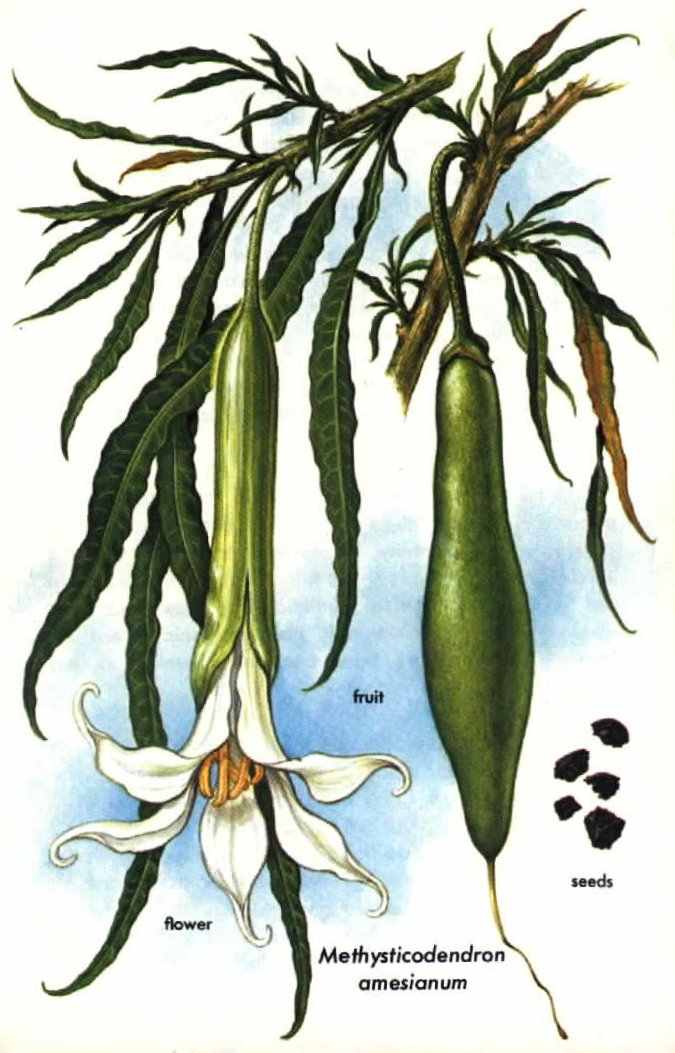
SHANIN (Petunia violacea) is one of the most recently reported hallucinogens. It is taken by the Indians in Ecuador to induce the sensation of flight. Although an alkaloid of unknown identity hos been reported from this species of petunia, phytochemical investigation of petunias is urgently needed.
Some 40 species of petunias grow in South America and in warmer parts of North America. Members of the nightshade family, Solanaceae, they are closely allied to the genus Nicotiana (tobacco). Petunia violacea as well as other species are horticulturally important. Cultivated varieties, with their attractive, funnel-shaped blooms, are popular garden flowers that bloom profusely throughout the summer months.
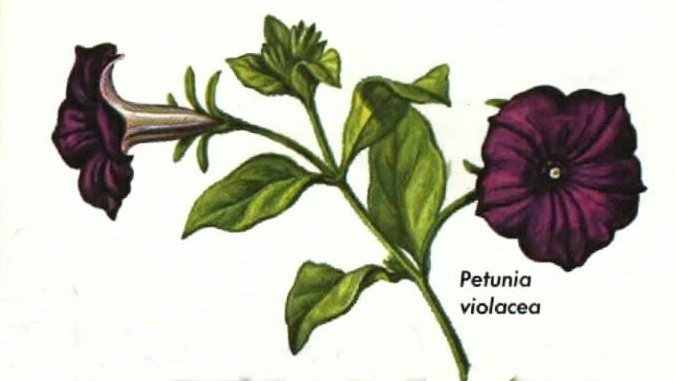
KEULE(Gomortega keule) is a small tree restricted to about 100 square miles in central Chile. It is the only species in a rare family, Gomortegaceae, related to the nutmeg family. The Mapuche Indions of Chile are soid to eat the fruit of keule, or hualhual, for intoxication, but whether the effects are truly hallucinogenic is not yet known. So far, there have been no chemical studies made of this tree.
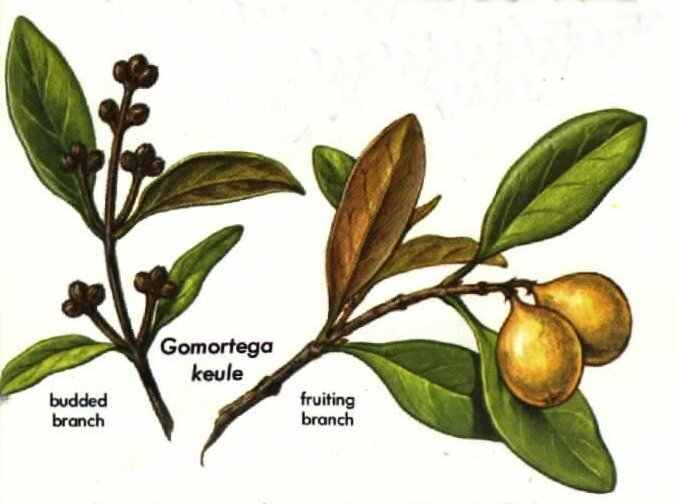
TAIQUE (Desfontainia hookeri) is a shrub of Andean valleys. Its leaves, made probably into a tea, are employed in southern Chile as a folk medicine and as a narcotic. Whether their effects are truly hallucinogenic is not known, nor has their chemical composition been investigated. The genus Desfontainia contains one or two other Andean species and belongs to the family Desfontainiaceae. A related family, Loganiaceae, includes the plants from which certain South American arrow poisons are made.
